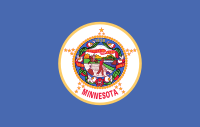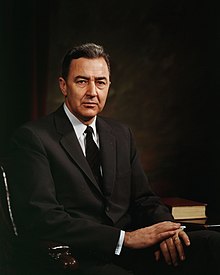The Minnesota Portal Minnesota (/ˌmɪnəˈsoʊtə/ ⓘ MIN-ə-SOH-tə) is a state in the Upper Midwestern region of the United States. It is the 12th largest U.S. state in area and the 22nd most populous, with over 5.75 million residents. Minnesota is known as the "Land of 10,000 Lakes" for having more than 14,000 bodies of fresh water covering at least ten acres each; roughly a third of the state is forested; much of the remainder is prairie and farmland. More than 60% of Minnesotans (about 3.7 million) live in the Minneapolis–Saint Paul metropolitan area, known as the "Twin Cities", the state's main political, economic, and cultural hub and the 16th-largest metropolitan area in the U.S. Other minor metropolitan and micropolitan statistical areas include Duluth, Mankato, Moorhead, Rochester, and St. Cloud. Minnesota, which gets its name from the Dakota language, has been inhabited by various Indigenous peoples since the Woodland period of the 11th century BCE. Between roughly 200 and 500 CE, two areas of the indigenous Hopewell tradition emerged: the Laurel complex in the north, and Trempealeau Hopewell in the Mississippi River Valley in the south. The Upper Mississippian culture, consisting of the Oneota people and other Siouan speakers, emerged around 1000 CE and lasted through the arrival of Europeans in the 17th century. French explorers and missionaries were the earliest Europeans to enter the region, encountering the Dakota, Ojibwe, and various Anishinaabe tribes. Much of what is now Minnesota formed part of the vast French holding of Louisiana, which the United States purchased in 1803. After several territorial reorganizations, the Minnesota Territory was admitted to the Union as the 32nd state in 1858. Minnesota's official motto, L'Étoile du Nord ("The Star of the North") is the only state motto in French; this phrase was adopted shortly after statehood and reflects both the state's early French explorers and its position as the northernmost state in the contiguous U.S. As part of the American frontier, Minnesota attracted settlers and homesteaders from across the country. Its growth was initially based on timber, agriculture, and railroad construction. Into the early 20th century, European immigrants arrived in significant numbers, particularly from Scandinavia, Germany, and Central Europe; many were linked to the failed revolutions of 1848, which partly influenced the state's development as a center of labor and social activism. Minnesota's rapid industrialization and urbanization precipitated major social, economic, and political changes in the late 19th and early 20th centuries; the state was at the forefront of labor rights, women's suffrage, and political reform. Consequently, Minnesota is unique among Midwestern states in being a relative stronghold of the Democratic Party, having voted for every Democratic presidential nominee since 1976, longer than any other U.S. state. (Full article...) Entries here consist of Good and Featured articles, which meet a core set of high editorial standards.
Gary Schiff (born February 3, 1972, as Gary J. Schiffhauer) is an American politician and activist who represented Ward 9 on the Minneapolis City Council. A member of the Minnesota Democratic-Farmer-Labor Party (DFL), he was first elected in 2001 and re-elected in 2005 and 2009. Prior to his political career, Schiff was involved with a variety of activist groups and causes ranging from human rights with the Human Rights Campaign, to historic preservation with Save Our Shubert. During his city council tenure, Schiff worked to ease ordinances prohibitive to small businesses, especially microbreweries, and strongly advocated against a publicly funded stadium for the Minnesota Vikings. In January 2013, Schiff began a campaign for mayor of Minneapolis in the 2013 election but after an unsuccessful DFL endorsement convention, dropped out of the race and backed eventual winner Betsy Hodges in mid-June. His third and final term on the City Council ended in January 2014. (Full article...)Selected article -Eugene Joseph McCarthy (March 29, 1916 – December 10, 2005) was an American politician, writer, and academic from Minnesota. He served in the United States House of Representatives from 1949 to 1959 and the United States Senate from 1959 to 1971. McCarthy sought the Democratic presidential nomination in the 1968 election, challenging incumbent Lyndon B. Johnson on an anti-Vietnam War platform. McCarthy unsuccessfully ran for U.S. president four more times. Born in Watkins, Minnesota, McCarthy became an economics professor after earning a graduate degree from the University of Minnesota. He served as a code breaker for the United States Department of War during World War II. McCarthy became a member of the Minnesota Democratic–Farmer–Labor Party (the state affiliate of the Democratic Party) and in 1948 was elected to the House of Representatives, where he served until being elected to the U.S. Senate in 1958. McCarthy was a prominent supporter of Adlai Stevenson II for the Democratic presidential nomination in 1960, and was himself a candidate for the Democratic vice-presidential nomination in 1964. He co-sponsored the Immigration and Nationality Act of 1965, though he later expressed regret about its impact and became a member of the Federation for American Immigration Reform. (Full article...)General images -The following are images from various Minnesota-related articles on Wikipedia.
Did you know -
Related portalsTopicsLargest cities
CategoriesNew articlesThis list was generated from these rules. Questions and feedback are always welcome! The search is being run daily with the most recent ~14 days of results. Note: Some articles may not be relevant to this project.
Rules | Match log | Results page (for watching) | Last updated: 2024-04-18 01:06 (UTC) Note: The list display can now be customized by each user. See List display personalization for details.
WikiProjectsTasks
Associated WikimediaThe following Wikimedia Foundation sister projects provide more on this subject:
Sources
Discover Wikipedia using portals |














































